Operations & Project Management: A Case Study of Unilever's PLC
VerifiedAdded on 2023/06/08
|14
|4475
|186
Report
AI Summary
This report provides a detailed analysis of operations and project management at Unilever, a multinational consumer goods company. It examines the principles of operations management, including planning, forecasting, quality control, and supply chain management. The report also analyzes the application of Six Sigma and lean manufacturing strategies for continuous improvement, focusing on waste reduction and process optimization. Furthermore, it explores the stages of the project life cycle (PLC) – initiating, planning, executing, monitoring-controlling, and closing – within Unilever's processes. The report also justifies the strategies used for continuous improvement, such as Lean Manufacturing and Six Sigma, and evaluates the effectiveness of the PLC through theoretical and practical exploration, offering recommendations for improvement. This document is available on Desklib, a platform providing study tools for students.
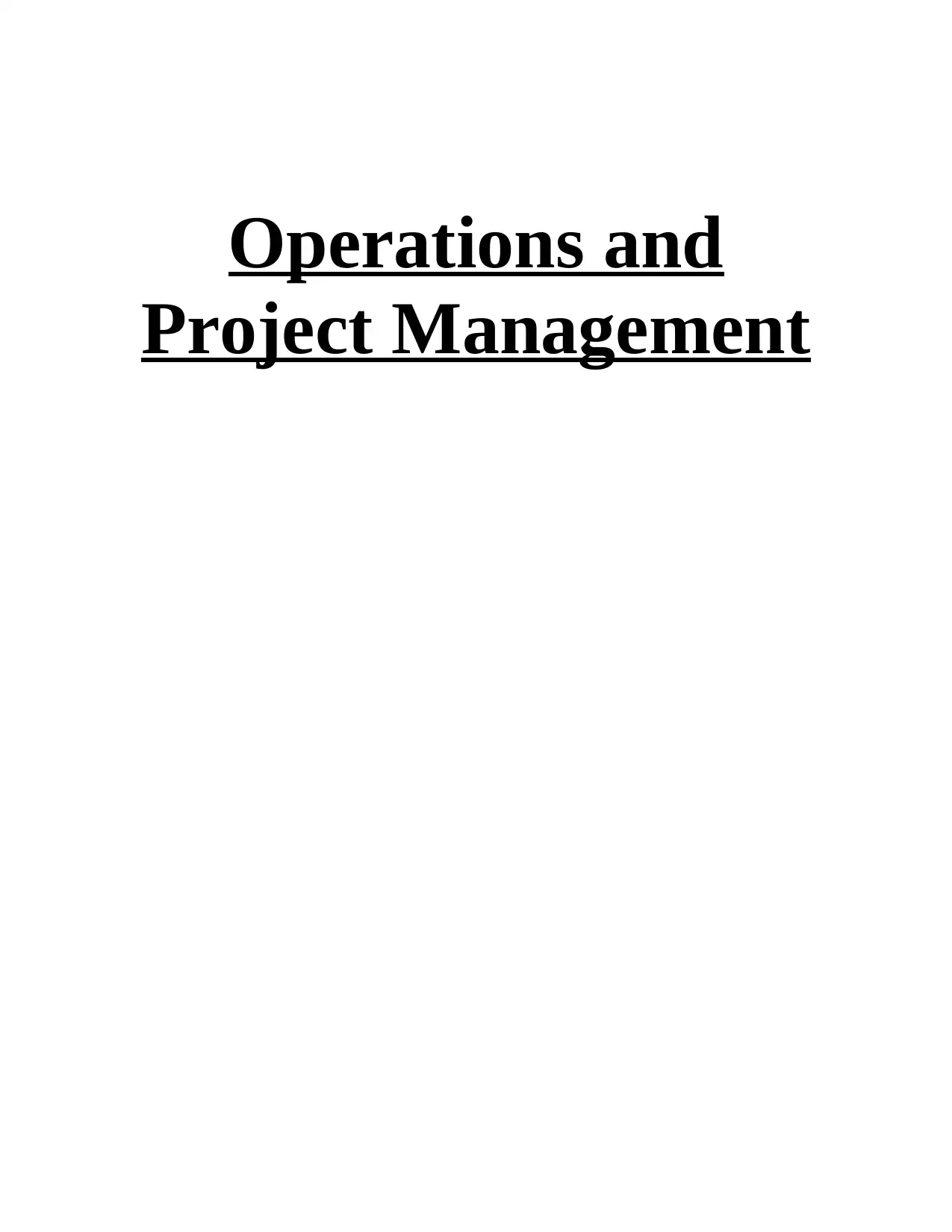
Operations and
Project Management
Project Management
Paraphrase This Document
Need a fresh take? Get an instant paraphrase of this document with our AI Paraphraser
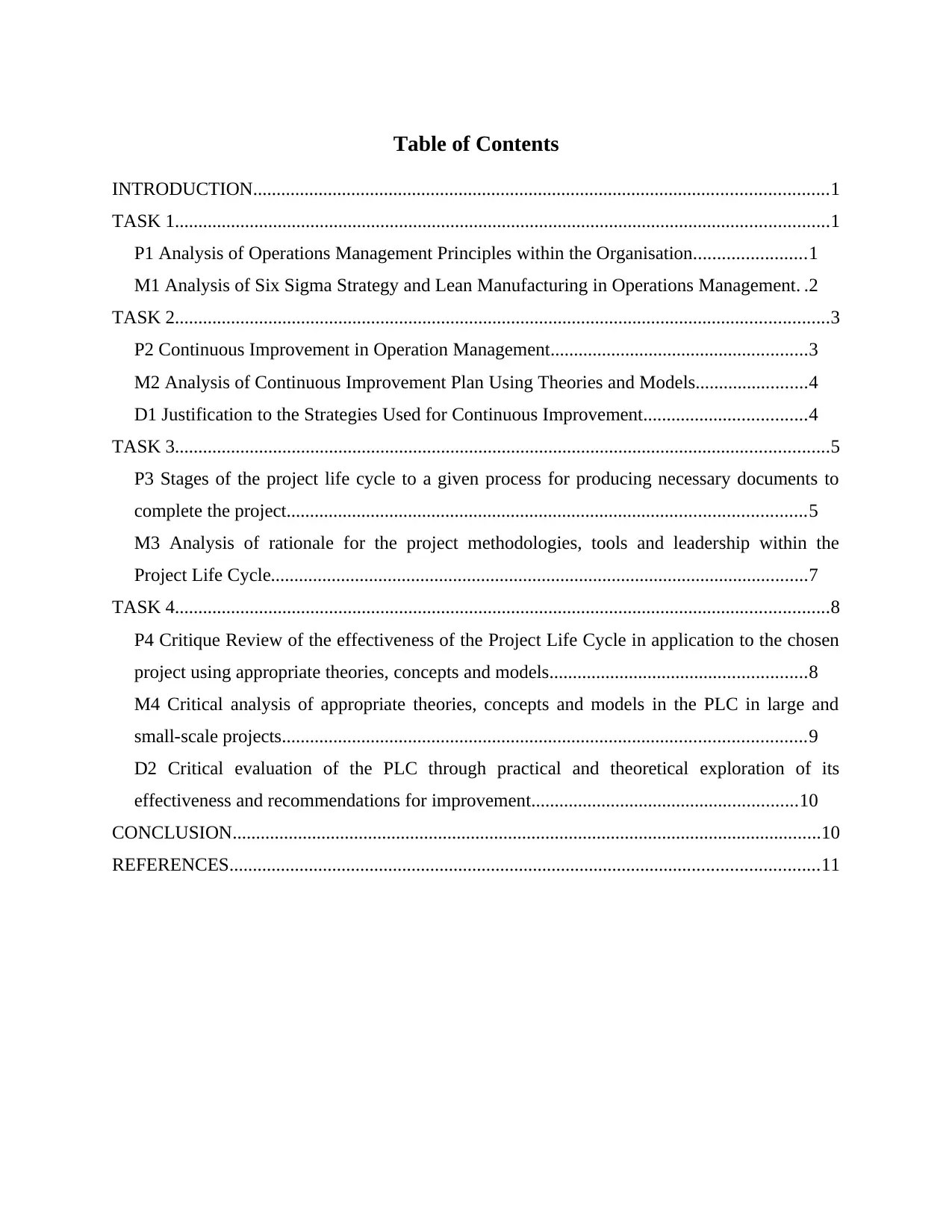
Table of Contents
INTRODUCTION...........................................................................................................................1
TASK 1............................................................................................................................................1
P1 Analysis of Operations Management Principles within the Organisation........................1
M1 Analysis of Six Sigma Strategy and Lean Manufacturing in Operations Management. .2
TASK 2............................................................................................................................................3
P2 Continuous Improvement in Operation Management.......................................................3
M2 Analysis of Continuous Improvement Plan Using Theories and Models........................4
D1 Justification to the Strategies Used for Continuous Improvement...................................4
TASK 3............................................................................................................................................5
P3 Stages of the project life cycle to a given process for producing necessary documents to
complete the project...............................................................................................................5
M3 Analysis of rationale for the project methodologies, tools and leadership within the
Project Life Cycle...................................................................................................................7
TASK 4............................................................................................................................................8
P4 Critique Review of the effectiveness of the Project Life Cycle in application to the chosen
project using appropriate theories, concepts and models.......................................................8
M4 Critical analysis of appropriate theories, concepts and models in the PLC in large and
small-scale projects................................................................................................................9
D2 Critical evaluation of the PLC through practical and theoretical exploration of its
effectiveness and recommendations for improvement.........................................................10
CONCLUSION..............................................................................................................................10
REFERENCES..............................................................................................................................11
INTRODUCTION...........................................................................................................................1
TASK 1............................................................................................................................................1
P1 Analysis of Operations Management Principles within the Organisation........................1
M1 Analysis of Six Sigma Strategy and Lean Manufacturing in Operations Management. .2
TASK 2............................................................................................................................................3
P2 Continuous Improvement in Operation Management.......................................................3
M2 Analysis of Continuous Improvement Plan Using Theories and Models........................4
D1 Justification to the Strategies Used for Continuous Improvement...................................4
TASK 3............................................................................................................................................5
P3 Stages of the project life cycle to a given process for producing necessary documents to
complete the project...............................................................................................................5
M3 Analysis of rationale for the project methodologies, tools and leadership within the
Project Life Cycle...................................................................................................................7
TASK 4............................................................................................................................................8
P4 Critique Review of the effectiveness of the Project Life Cycle in application to the chosen
project using appropriate theories, concepts and models.......................................................8
M4 Critical analysis of appropriate theories, concepts and models in the PLC in large and
small-scale projects................................................................................................................9
D2 Critical evaluation of the PLC through practical and theoretical exploration of its
effectiveness and recommendations for improvement.........................................................10
CONCLUSION..............................................................................................................................10
REFERENCES..............................................................................................................................11
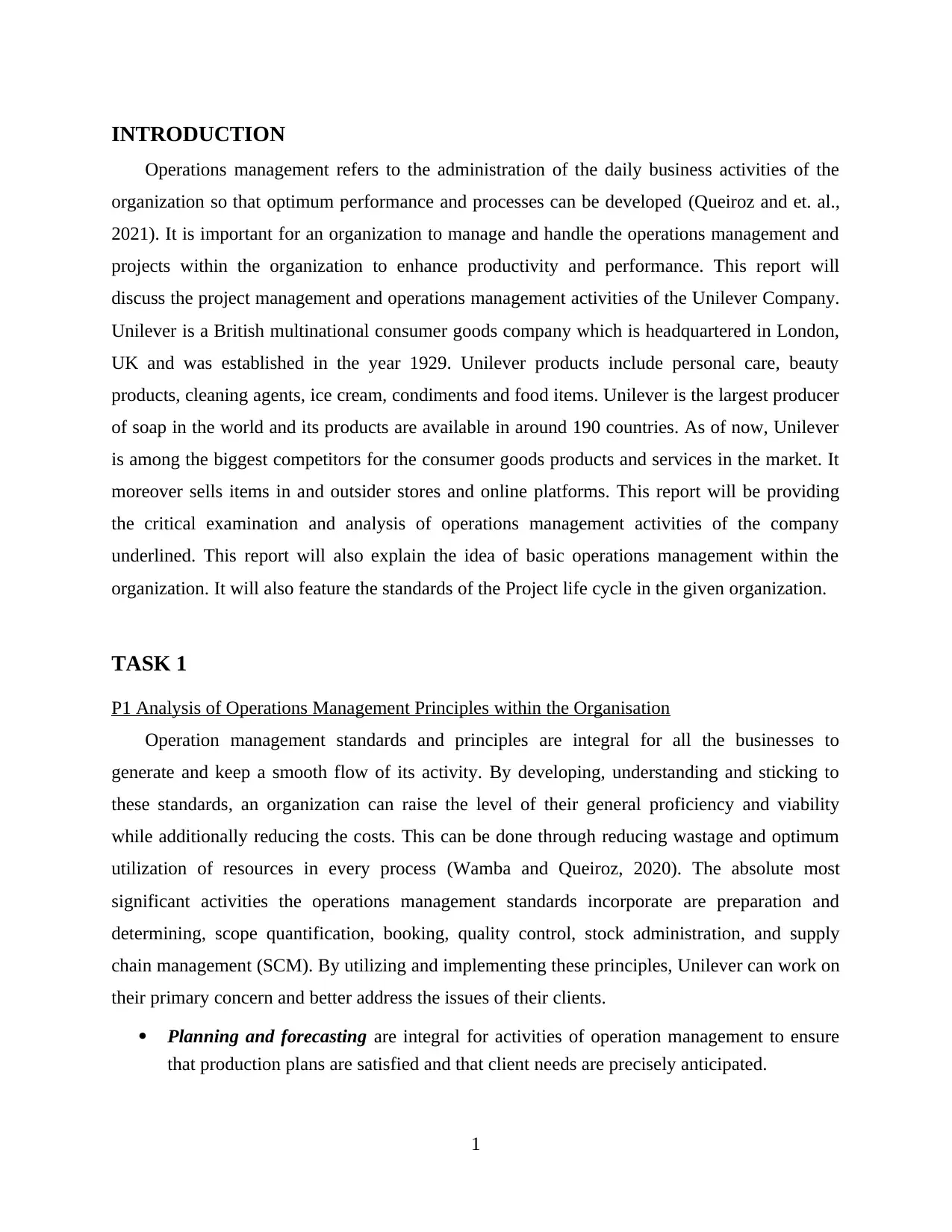
INTRODUCTION
Operations management refers to the administration of the daily business activities of the
organization so that optimum performance and processes can be developed (Queiroz and et. al.,
2021). It is important for an organization to manage and handle the operations management and
projects within the organization to enhance productivity and performance. This report will
discuss the project management and operations management activities of the Unilever Company.
Unilever is a British multinational consumer goods company which is headquartered in London,
UK and was established in the year 1929. Unilever products include personal care, beauty
products, cleaning agents, ice cream, condiments and food items. Unilever is the largest producer
of soap in the world and its products are available in around 190 countries. As of now, Unilever
is among the biggest competitors for the consumer goods products and services in the market. It
moreover sells items in and outsider stores and online platforms. This report will be providing
the critical examination and analysis of operations management activities of the company
underlined. This report will also explain the idea of basic operations management within the
organization. It will also feature the standards of the Project life cycle in the given organization.
TASK 1
P1 Analysis of Operations Management Principles within the Organisation
Operation management standards and principles are integral for all the businesses to
generate and keep a smooth flow of its activity. By developing, understanding and sticking to
these standards, an organization can raise the level of their general proficiency and viability
while additionally reducing the costs. This can be done through reducing wastage and optimum
utilization of resources in every process (Wamba and Queiroz, 2020). The absolute most
significant activities the operations management standards incorporate are preparation and
determining, scope quantification, booking, quality control, stock administration, and supply
chain management (SCM). By utilizing and implementing these principles, Unilever can work on
their primary concern and better address the issues of their clients.
Planning and forecasting are integral for activities of operation management to ensure
that production plans are satisfied and that client needs are precisely anticipated.
1
Operations management refers to the administration of the daily business activities of the
organization so that optimum performance and processes can be developed (Queiroz and et. al.,
2021). It is important for an organization to manage and handle the operations management and
projects within the organization to enhance productivity and performance. This report will
discuss the project management and operations management activities of the Unilever Company.
Unilever is a British multinational consumer goods company which is headquartered in London,
UK and was established in the year 1929. Unilever products include personal care, beauty
products, cleaning agents, ice cream, condiments and food items. Unilever is the largest producer
of soap in the world and its products are available in around 190 countries. As of now, Unilever
is among the biggest competitors for the consumer goods products and services in the market. It
moreover sells items in and outsider stores and online platforms. This report will be providing
the critical examination and analysis of operations management activities of the company
underlined. This report will also explain the idea of basic operations management within the
organization. It will also feature the standards of the Project life cycle in the given organization.
TASK 1
P1 Analysis of Operations Management Principles within the Organisation
Operation management standards and principles are integral for all the businesses to
generate and keep a smooth flow of its activity. By developing, understanding and sticking to
these standards, an organization can raise the level of their general proficiency and viability
while additionally reducing the costs. This can be done through reducing wastage and optimum
utilization of resources in every process (Wamba and Queiroz, 2020). The absolute most
significant activities the operations management standards incorporate are preparation and
determining, scope quantification, booking, quality control, stock administration, and supply
chain management (SCM). By utilizing and implementing these principles, Unilever can work on
their primary concern and better address the issues of their clients.
Planning and forecasting are integral for activities of operation management to ensure
that production plans are satisfied and that client needs are precisely anticipated.
1
⊘ This is a preview!⊘
Do you want full access?
Subscribe today to unlock all pages.

Trusted by 1+ million students worldwide
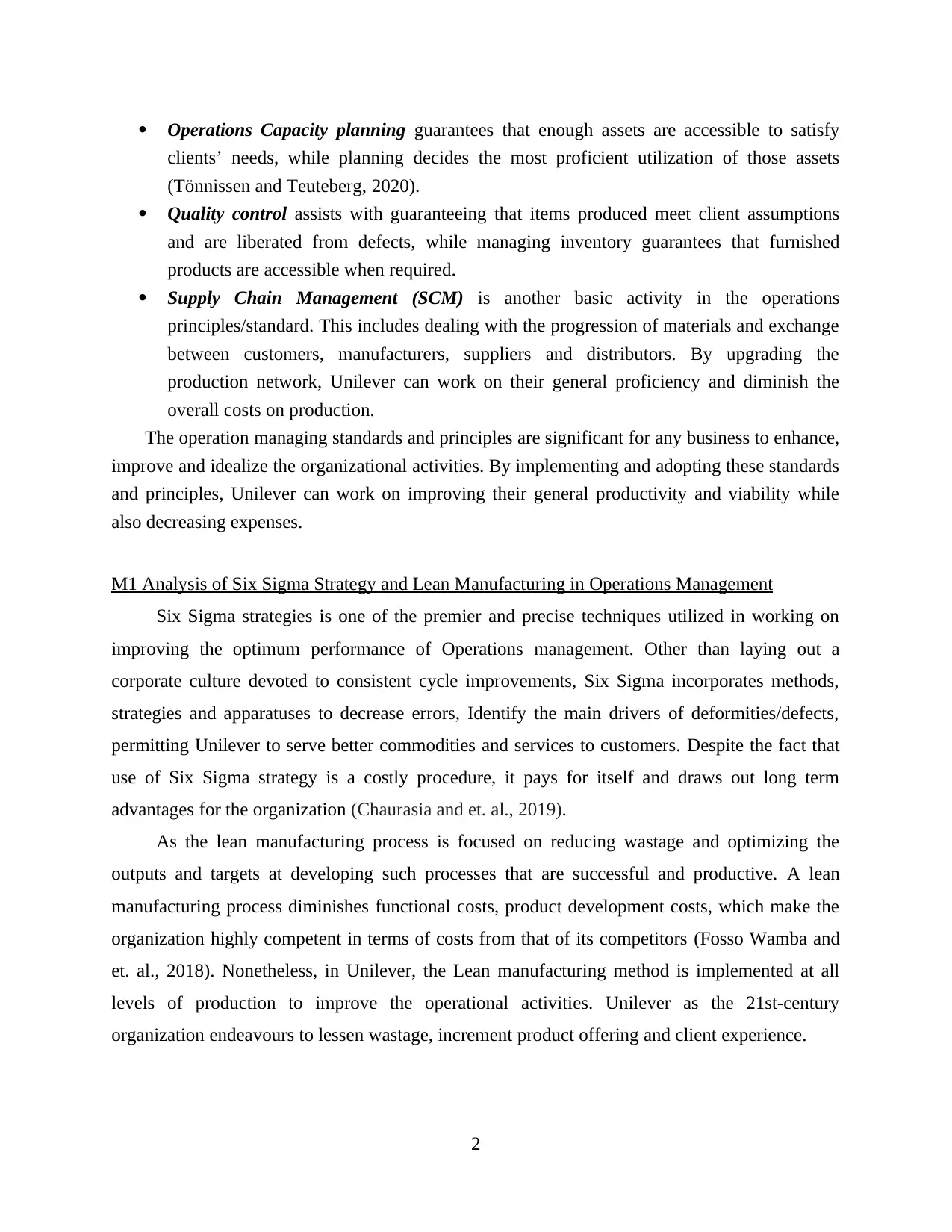
Operations Capacity planning guarantees that enough assets are accessible to satisfy
clients’ needs, while planning decides the most proficient utilization of those assets
(Tönnissen and Teuteberg, 2020).
Quality control assists with guaranteeing that items produced meet client assumptions
and are liberated from defects, while managing inventory guarantees that furnished
products are accessible when required.
Supply Chain Management (SCM) is another basic activity in the operations
principles/standard. This includes dealing with the progression of materials and exchange
between customers, manufacturers, suppliers and distributors. By upgrading the
production network, Unilever can work on their general proficiency and diminish the
overall costs on production.
The operation managing standards and principles are significant for any business to enhance,
improve and idealize the organizational activities. By implementing and adopting these standards
and principles, Unilever can work on improving their general productivity and viability while
also decreasing expenses.
M1 Analysis of Six Sigma Strategy and Lean Manufacturing in Operations Management
Six Sigma strategies is one of the premier and precise techniques utilized in working on
improving the optimum performance of Operations management. Other than laying out a
corporate culture devoted to consistent cycle improvements, Six Sigma incorporates methods,
strategies and apparatuses to decrease errors, Identify the main drivers of deformities/defects,
permitting Unilever to serve better commodities and services to customers. Despite the fact that
use of Six Sigma strategy is a costly procedure, it pays for itself and draws out long term
advantages for the organization (Chaurasia and et. al., 2019).
As the lean manufacturing process is focused on reducing wastage and optimizing the
outputs and targets at developing such processes that are successful and productive. A lean
manufacturing process diminishes functional costs, product development costs, which make the
organization highly competent in terms of costs from that of its competitors (Fosso Wamba and
et. al., 2018). Nonetheless, in Unilever, the Lean manufacturing method is implemented at all
levels of production to improve the operational activities. Unilever as the 21st-century
organization endeavours to lessen wastage, increment product offering and client experience.
2
clients’ needs, while planning decides the most proficient utilization of those assets
(Tönnissen and Teuteberg, 2020).
Quality control assists with guaranteeing that items produced meet client assumptions
and are liberated from defects, while managing inventory guarantees that furnished
products are accessible when required.
Supply Chain Management (SCM) is another basic activity in the operations
principles/standard. This includes dealing with the progression of materials and exchange
between customers, manufacturers, suppliers and distributors. By upgrading the
production network, Unilever can work on their general proficiency and diminish the
overall costs on production.
The operation managing standards and principles are significant for any business to enhance,
improve and idealize the organizational activities. By implementing and adopting these standards
and principles, Unilever can work on improving their general productivity and viability while
also decreasing expenses.
M1 Analysis of Six Sigma Strategy and Lean Manufacturing in Operations Management
Six Sigma strategies is one of the premier and precise techniques utilized in working on
improving the optimum performance of Operations management. Other than laying out a
corporate culture devoted to consistent cycle improvements, Six Sigma incorporates methods,
strategies and apparatuses to decrease errors, Identify the main drivers of deformities/defects,
permitting Unilever to serve better commodities and services to customers. Despite the fact that
use of Six Sigma strategy is a costly procedure, it pays for itself and draws out long term
advantages for the organization (Chaurasia and et. al., 2019).
As the lean manufacturing process is focused on reducing wastage and optimizing the
outputs and targets at developing such processes that are successful and productive. A lean
manufacturing process diminishes functional costs, product development costs, which make the
organization highly competent in terms of costs from that of its competitors (Fosso Wamba and
et. al., 2018). Nonetheless, in Unilever, the Lean manufacturing method is implemented at all
levels of production to improve the operational activities. Unilever as the 21st-century
organization endeavours to lessen wastage, increment product offering and client experience.
2
Paraphrase This Document
Need a fresh take? Get an instant paraphrase of this document with our AI Paraphraser
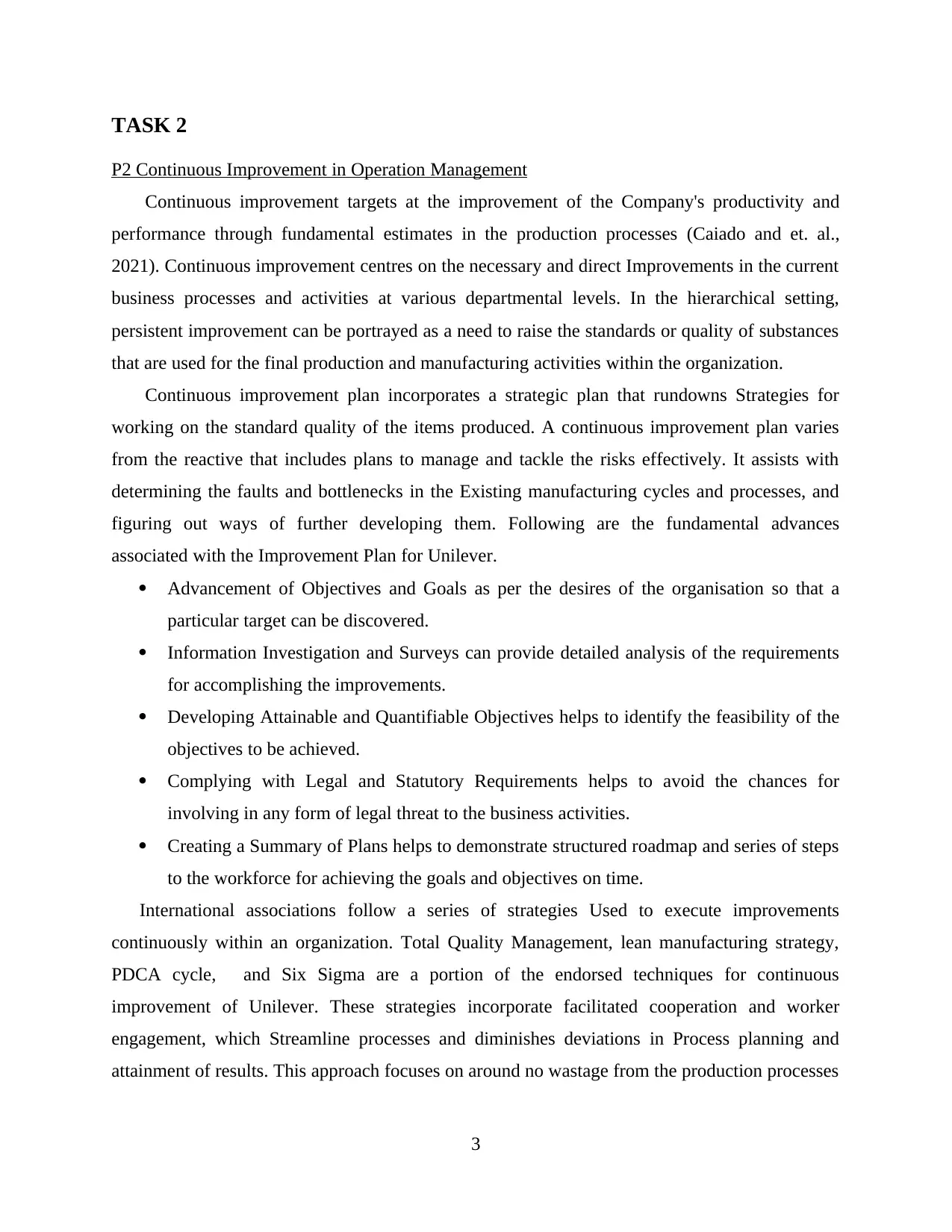
TASK 2
P2 Continuous Improvement in Operation Management
Continuous improvement targets at the improvement of the Company's productivity and
performance through fundamental estimates in the production processes (Caiado and et. al.,
2021). Continuous improvement centres on the necessary and direct Improvements in the current
business processes and activities at various departmental levels. In the hierarchical setting,
persistent improvement can be portrayed as a need to raise the standards or quality of substances
that are used for the final production and manufacturing activities within the organization.
Continuous improvement plan incorporates a strategic plan that rundowns Strategies for
working on the standard quality of the items produced. A continuous improvement plan varies
from the reactive that includes plans to manage and tackle the risks effectively. It assists with
determining the faults and bottlenecks in the Existing manufacturing cycles and processes, and
figuring out ways of further developing them. Following are the fundamental advances
associated with the Improvement Plan for Unilever.
Advancement of Objectives and Goals as per the desires of the organisation so that a
particular target can be discovered.
Information Investigation and Surveys can provide detailed analysis of the requirements
for accomplishing the improvements.
Developing Attainable and Quantifiable Objectives helps to identify the feasibility of the
objectives to be achieved.
Complying with Legal and Statutory Requirements helps to avoid the chances for
involving in any form of legal threat to the business activities.
Creating a Summary of Plans helps to demonstrate structured roadmap and series of steps
to the workforce for achieving the goals and objectives on time.
International associations follow a series of strategies Used to execute improvements
continuously within an organization. Total Quality Management, lean manufacturing strategy,
PDCA cycle, and Six Sigma are a portion of the endorsed techniques for continuous
improvement of Unilever. These strategies incorporate facilitated cooperation and worker
engagement, which Streamline processes and diminishes deviations in Process planning and
attainment of results. This approach focuses on around no wastage from the production processes
3
P2 Continuous Improvement in Operation Management
Continuous improvement targets at the improvement of the Company's productivity and
performance through fundamental estimates in the production processes (Caiado and et. al.,
2021). Continuous improvement centres on the necessary and direct Improvements in the current
business processes and activities at various departmental levels. In the hierarchical setting,
persistent improvement can be portrayed as a need to raise the standards or quality of substances
that are used for the final production and manufacturing activities within the organization.
Continuous improvement plan incorporates a strategic plan that rundowns Strategies for
working on the standard quality of the items produced. A continuous improvement plan varies
from the reactive that includes plans to manage and tackle the risks effectively. It assists with
determining the faults and bottlenecks in the Existing manufacturing cycles and processes, and
figuring out ways of further developing them. Following are the fundamental advances
associated with the Improvement Plan for Unilever.
Advancement of Objectives and Goals as per the desires of the organisation so that a
particular target can be discovered.
Information Investigation and Surveys can provide detailed analysis of the requirements
for accomplishing the improvements.
Developing Attainable and Quantifiable Objectives helps to identify the feasibility of the
objectives to be achieved.
Complying with Legal and Statutory Requirements helps to avoid the chances for
involving in any form of legal threat to the business activities.
Creating a Summary of Plans helps to demonstrate structured roadmap and series of steps
to the workforce for achieving the goals and objectives on time.
International associations follow a series of strategies Used to execute improvements
continuously within an organization. Total Quality Management, lean manufacturing strategy,
PDCA cycle, and Six Sigma are a portion of the endorsed techniques for continuous
improvement of Unilever. These strategies incorporate facilitated cooperation and worker
engagement, which Streamline processes and diminishes deviations in Process planning and
attainment of results. This approach focuses on around no wastage from the production processes
3
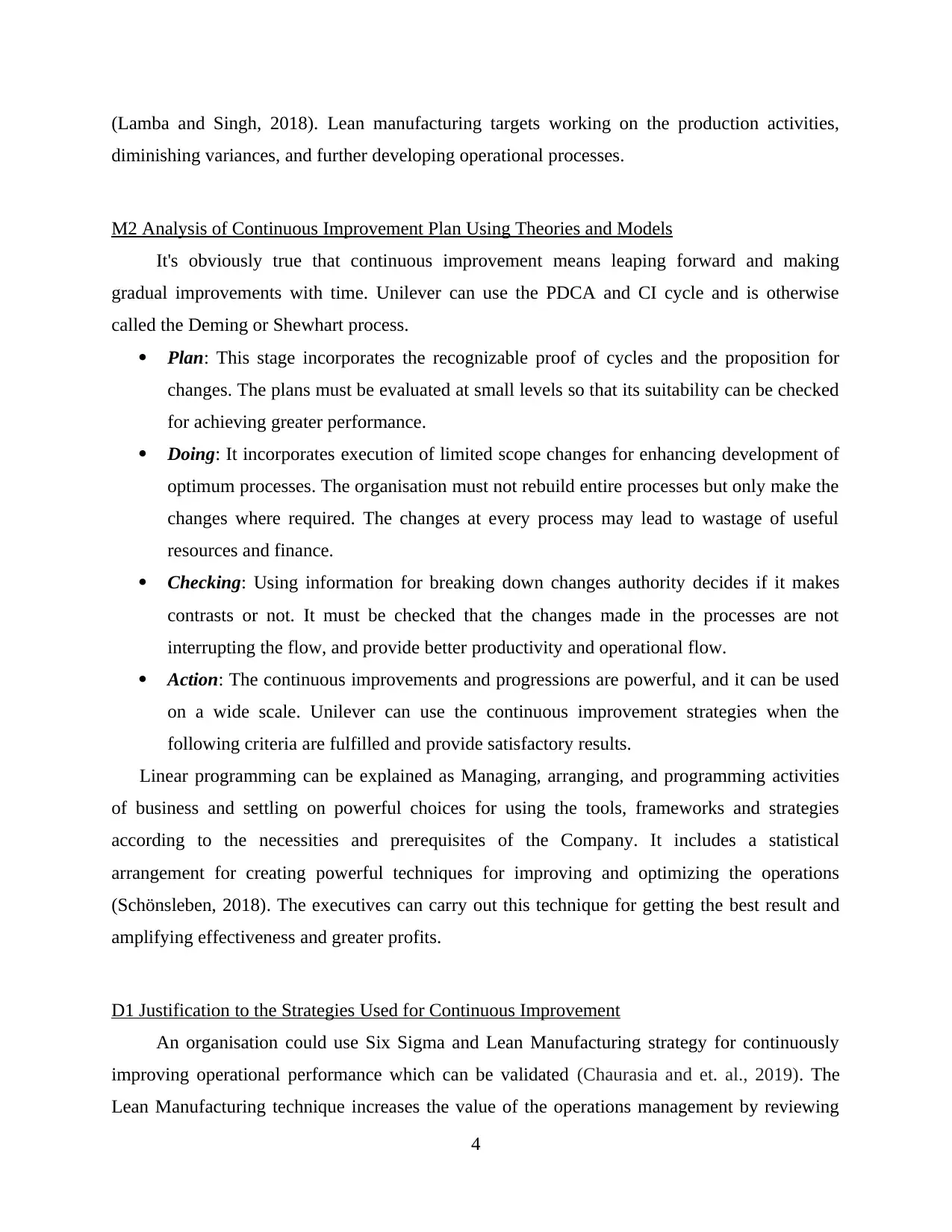
(Lamba and Singh, 2018). Lean manufacturing targets working on the production activities,
diminishing variances, and further developing operational processes.
M2 Analysis of Continuous Improvement Plan Using Theories and Models
It's obviously true that continuous improvement means leaping forward and making
gradual improvements with time. Unilever can use the PDCA and CI cycle and is otherwise
called the Deming or Shewhart process.
Plan: This stage incorporates the recognizable proof of cycles and the proposition for
changes. The plans must be evaluated at small levels so that its suitability can be checked
for achieving greater performance.
Doing: It incorporates execution of limited scope changes for enhancing development of
optimum processes. The organisation must not rebuild entire processes but only make the
changes where required. The changes at every process may lead to wastage of useful
resources and finance.
Checking: Using information for breaking down changes authority decides if it makes
contrasts or not. It must be checked that the changes made in the processes are not
interrupting the flow, and provide better productivity and operational flow.
Action: The continuous improvements and progressions are powerful, and it can be used
on a wide scale. Unilever can use the continuous improvement strategies when the
following criteria are fulfilled and provide satisfactory results.
Linear programming can be explained as Managing, arranging, and programming activities
of business and settling on powerful choices for using the tools, frameworks and strategies
according to the necessities and prerequisites of the Company. It includes a statistical
arrangement for creating powerful techniques for improving and optimizing the operations
(Schönsleben, 2018). The executives can carry out this technique for getting the best result and
amplifying effectiveness and greater profits.
D1 Justification to the Strategies Used for Continuous Improvement
An organisation could use Six Sigma and Lean Manufacturing strategy for continuously
improving operational performance which can be validated (Chaurasia and et. al., 2019). The
Lean Manufacturing technique increases the value of the operations management by reviewing
4
diminishing variances, and further developing operational processes.
M2 Analysis of Continuous Improvement Plan Using Theories and Models
It's obviously true that continuous improvement means leaping forward and making
gradual improvements with time. Unilever can use the PDCA and CI cycle and is otherwise
called the Deming or Shewhart process.
Plan: This stage incorporates the recognizable proof of cycles and the proposition for
changes. The plans must be evaluated at small levels so that its suitability can be checked
for achieving greater performance.
Doing: It incorporates execution of limited scope changes for enhancing development of
optimum processes. The organisation must not rebuild entire processes but only make the
changes where required. The changes at every process may lead to wastage of useful
resources and finance.
Checking: Using information for breaking down changes authority decides if it makes
contrasts or not. It must be checked that the changes made in the processes are not
interrupting the flow, and provide better productivity and operational flow.
Action: The continuous improvements and progressions are powerful, and it can be used
on a wide scale. Unilever can use the continuous improvement strategies when the
following criteria are fulfilled and provide satisfactory results.
Linear programming can be explained as Managing, arranging, and programming activities
of business and settling on powerful choices for using the tools, frameworks and strategies
according to the necessities and prerequisites of the Company. It includes a statistical
arrangement for creating powerful techniques for improving and optimizing the operations
(Schönsleben, 2018). The executives can carry out this technique for getting the best result and
amplifying effectiveness and greater profits.
D1 Justification to the Strategies Used for Continuous Improvement
An organisation could use Six Sigma and Lean Manufacturing strategy for continuously
improving operational performance which can be validated (Chaurasia and et. al., 2019). The
Lean Manufacturing technique increases the value of the operations management by reviewing
4
⊘ This is a preview!⊘
Do you want full access?
Subscribe today to unlock all pages.

Trusted by 1+ million students worldwide
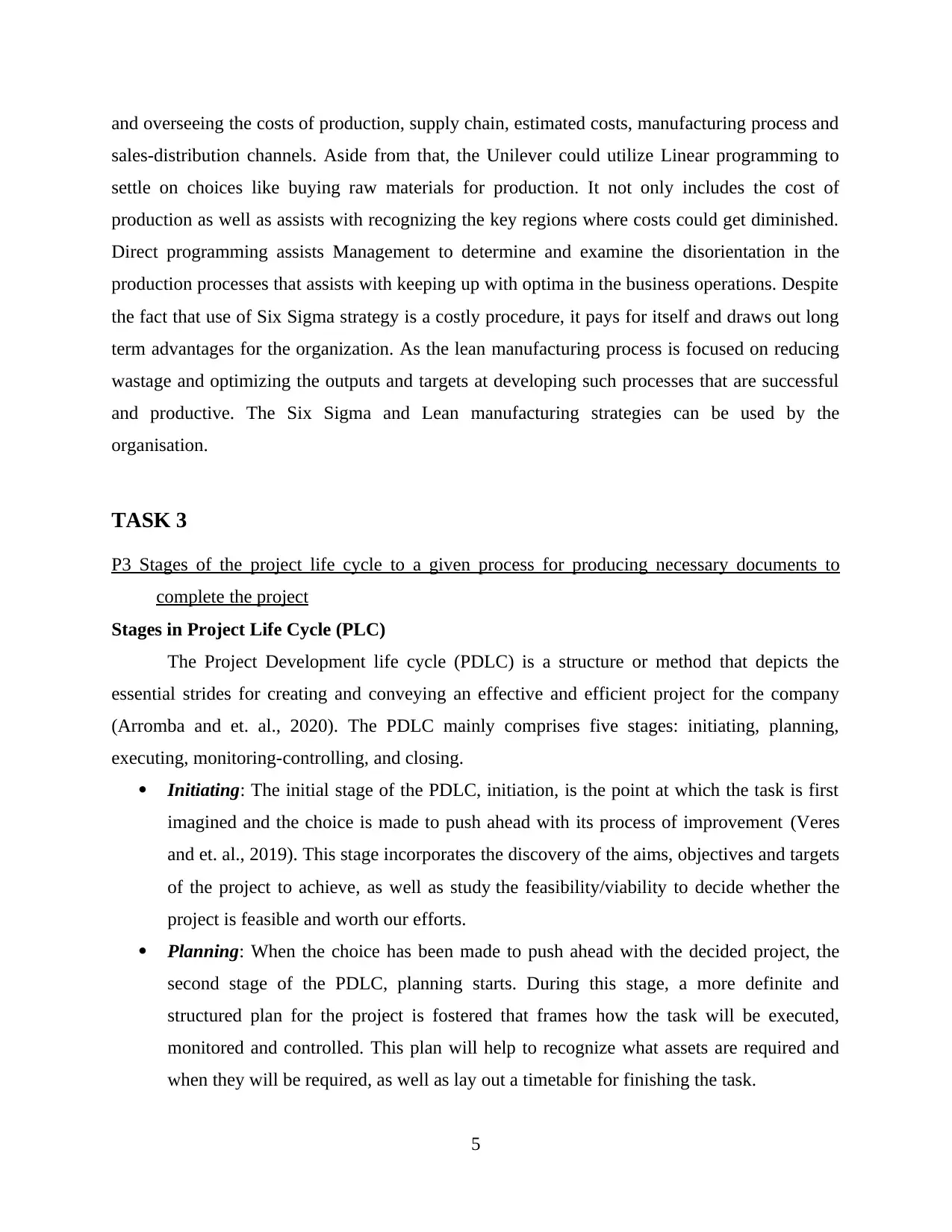
and overseeing the costs of production, supply chain, estimated costs, manufacturing process and
sales-distribution channels. Aside from that, the Unilever could utilize Linear programming to
settle on choices like buying raw materials for production. It not only includes the cost of
production as well as assists with recognizing the key regions where costs could get diminished.
Direct programming assists Management to determine and examine the disorientation in the
production processes that assists with keeping up with optima in the business operations. Despite
the fact that use of Six Sigma strategy is a costly procedure, it pays for itself and draws out long
term advantages for the organization. As the lean manufacturing process is focused on reducing
wastage and optimizing the outputs and targets at developing such processes that are successful
and productive. The Six Sigma and Lean manufacturing strategies can be used by the
organisation.
TASK 3
P3 Stages of the project life cycle to a given process for producing necessary documents to
complete the project
Stages in Project Life Cycle (PLC)
The Project Development life cycle (PDLC) is a structure or method that depicts the
essential strides for creating and conveying an effective and efficient project for the company
(Arromba and et. al., 2020). The PDLC mainly comprises five stages: initiating, planning,
executing, monitoring-controlling, and closing.
Initiating: The initial stage of the PDLC, initiation, is the point at which the task is first
imagined and the choice is made to push ahead with its process of improvement (Veres
and et. al., 2019). This stage incorporates the discovery of the aims, objectives and targets
of the project to achieve, as well as study the feasibility/viability to decide whether the
project is feasible and worth our efforts.
Planning: When the choice has been made to push ahead with the decided project, the
second stage of the PDLC, planning starts. During this stage, a more definite and
structured plan for the project is fostered that frames how the task will be executed,
monitored and controlled. This plan will help to recognize what assets are required and
when they will be required, as well as lay out a timetable for finishing the task.
5
sales-distribution channels. Aside from that, the Unilever could utilize Linear programming to
settle on choices like buying raw materials for production. It not only includes the cost of
production as well as assists with recognizing the key regions where costs could get diminished.
Direct programming assists Management to determine and examine the disorientation in the
production processes that assists with keeping up with optima in the business operations. Despite
the fact that use of Six Sigma strategy is a costly procedure, it pays for itself and draws out long
term advantages for the organization. As the lean manufacturing process is focused on reducing
wastage and optimizing the outputs and targets at developing such processes that are successful
and productive. The Six Sigma and Lean manufacturing strategies can be used by the
organisation.
TASK 3
P3 Stages of the project life cycle to a given process for producing necessary documents to
complete the project
Stages in Project Life Cycle (PLC)
The Project Development life cycle (PDLC) is a structure or method that depicts the
essential strides for creating and conveying an effective and efficient project for the company
(Arromba and et. al., 2020). The PDLC mainly comprises five stages: initiating, planning,
executing, monitoring-controlling, and closing.
Initiating: The initial stage of the PDLC, initiation, is the point at which the task is first
imagined and the choice is made to push ahead with its process of improvement (Veres
and et. al., 2019). This stage incorporates the discovery of the aims, objectives and targets
of the project to achieve, as well as study the feasibility/viability to decide whether the
project is feasible and worth our efforts.
Planning: When the choice has been made to push ahead with the decided project, the
second stage of the PDLC, planning starts. During this stage, a more definite and
structured plan for the project is fostered that frames how the task will be executed,
monitored and controlled. This plan will help to recognize what assets are required and
when they will be required, as well as lay out a timetable for finishing the task.
5
Paraphrase This Document
Need a fresh take? Get an instant paraphrase of this document with our AI Paraphraser
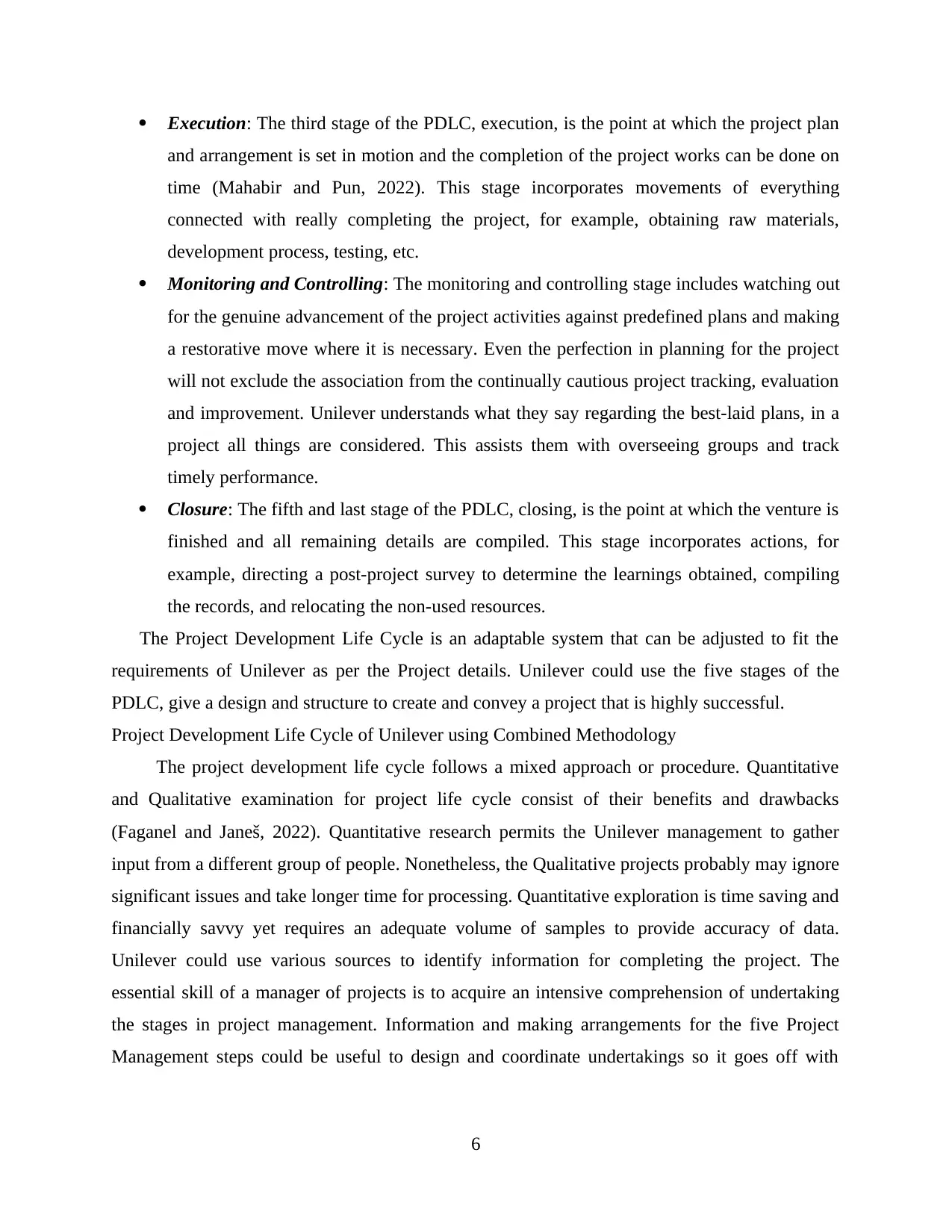
Execution: The third stage of the PDLC, execution, is the point at which the project plan
and arrangement is set in motion and the completion of the project works can be done on
time (Mahabir and Pun, 2022). This stage incorporates movements of everything
connected with really completing the project, for example, obtaining raw materials,
development process, testing, etc.
Monitoring and Controlling: The monitoring and controlling stage includes watching out
for the genuine advancement of the project activities against predefined plans and making
a restorative move where it is necessary. Even the perfection in planning for the project
will not exclude the association from the continually cautious project tracking, evaluation
and improvement. Unilever understands what they say regarding the best-laid plans, in a
project all things are considered. This assists them with overseeing groups and track
timely performance.
Closure: The fifth and last stage of the PDLC, closing, is the point at which the venture is
finished and all remaining details are compiled. This stage incorporates actions, for
example, directing a post-project survey to determine the learnings obtained, compiling
the records, and relocating the non-used resources.
The Project Development Life Cycle is an adaptable system that can be adjusted to fit the
requirements of Unilever as per the Project details. Unilever could use the five stages of the
PDLC, give a design and structure to create and convey a project that is highly successful.
Project Development Life Cycle of Unilever using Combined Methodology
The project development life cycle follows a mixed approach or procedure. Quantitative
and Qualitative examination for project life cycle consist of their benefits and drawbacks
(Faganel and Janeš, 2022). Quantitative research permits the Unilever management to gather
input from a different group of people. Nonetheless, the Qualitative projects probably may ignore
significant issues and take longer time for processing. Quantitative exploration is time saving and
financially savvy yet requires an adequate volume of samples to provide accuracy of data.
Unilever could use various sources to identify information for completing the project. The
essential skill of a manager of projects is to acquire an intensive comprehension of undertaking
the stages in project management. Information and making arrangements for the five Project
Management steps could be useful to design and coordinate undertakings so it goes off with
6
and arrangement is set in motion and the completion of the project works can be done on
time (Mahabir and Pun, 2022). This stage incorporates movements of everything
connected with really completing the project, for example, obtaining raw materials,
development process, testing, etc.
Monitoring and Controlling: The monitoring and controlling stage includes watching out
for the genuine advancement of the project activities against predefined plans and making
a restorative move where it is necessary. Even the perfection in planning for the project
will not exclude the association from the continually cautious project tracking, evaluation
and improvement. Unilever understands what they say regarding the best-laid plans, in a
project all things are considered. This assists them with overseeing groups and track
timely performance.
Closure: The fifth and last stage of the PDLC, closing, is the point at which the venture is
finished and all remaining details are compiled. This stage incorporates actions, for
example, directing a post-project survey to determine the learnings obtained, compiling
the records, and relocating the non-used resources.
The Project Development Life Cycle is an adaptable system that can be adjusted to fit the
requirements of Unilever as per the Project details. Unilever could use the five stages of the
PDLC, give a design and structure to create and convey a project that is highly successful.
Project Development Life Cycle of Unilever using Combined Methodology
The project development life cycle follows a mixed approach or procedure. Quantitative
and Qualitative examination for project life cycle consist of their benefits and drawbacks
(Faganel and Janeš, 2022). Quantitative research permits the Unilever management to gather
input from a different group of people. Nonetheless, the Qualitative projects probably may ignore
significant issues and take longer time for processing. Quantitative exploration is time saving and
financially savvy yet requires an adequate volume of samples to provide accuracy of data.
Unilever could use various sources to identify information for completing the project. The
essential skill of a manager of projects is to acquire an intensive comprehension of undertaking
the stages in project management. Information and making arrangements for the five Project
Management steps could be useful to design and coordinate undertakings so it goes off with
6
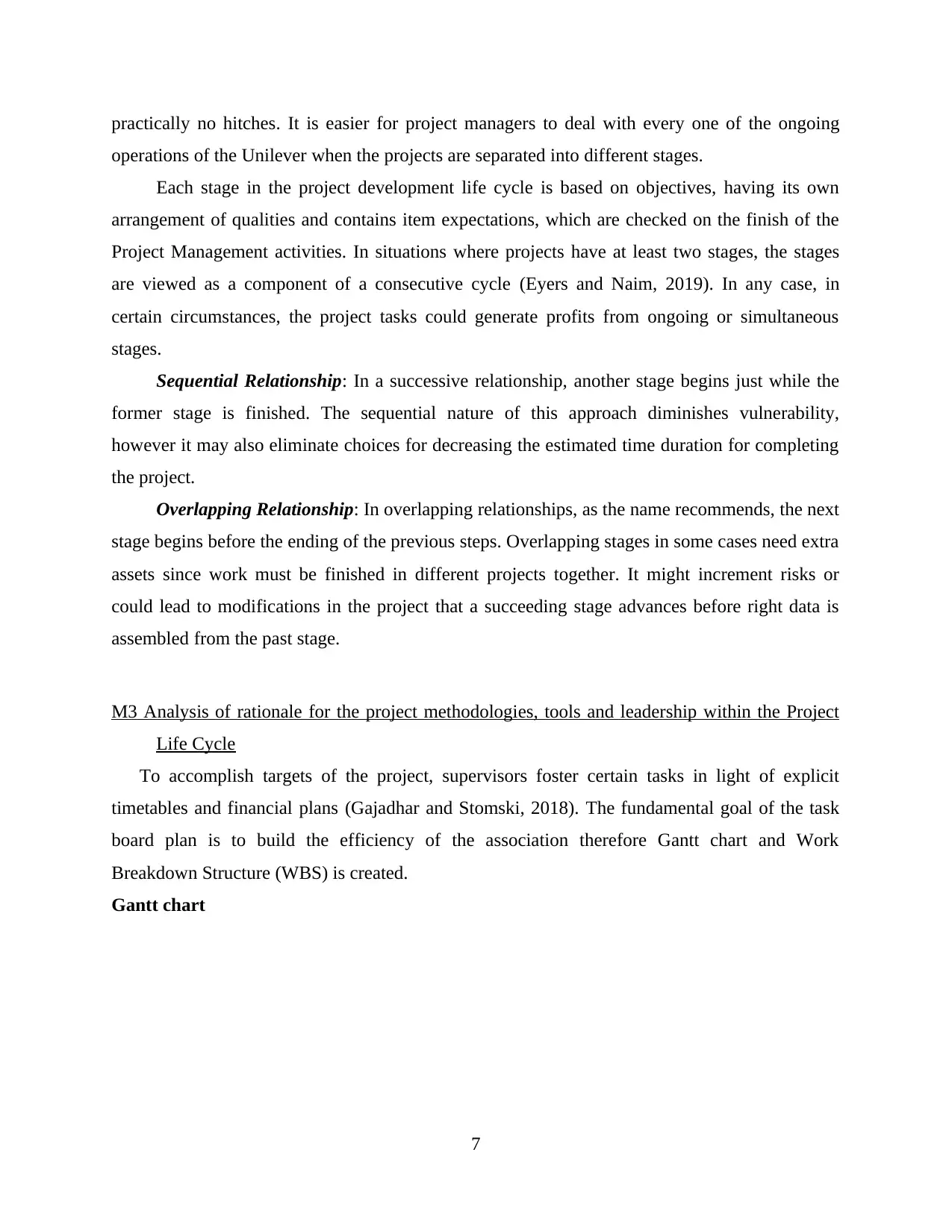
practically no hitches. It is easier for project managers to deal with every one of the ongoing
operations of the Unilever when the projects are separated into different stages.
Each stage in the project development life cycle is based on objectives, having its own
arrangement of qualities and contains item expectations, which are checked on the finish of the
Project Management activities. In situations where projects have at least two stages, the stages
are viewed as a component of a consecutive cycle (Eyers and Naim, 2019). In any case, in
certain circumstances, the project tasks could generate profits from ongoing or simultaneous
stages.
Sequential Relationship: In a successive relationship, another stage begins just while the
former stage is finished. The sequential nature of this approach diminishes vulnerability,
however it may also eliminate choices for decreasing the estimated time duration for completing
the project.
Overlapping Relationship: In overlapping relationships, as the name recommends, the next
stage begins before the ending of the previous steps. Overlapping stages in some cases need extra
assets since work must be finished in different projects together. It might increment risks or
could lead to modifications in the project that a succeeding stage advances before right data is
assembled from the past stage.
M3 Analysis of rationale for the project methodologies, tools and leadership within the Project
Life Cycle
To accomplish targets of the project, supervisors foster certain tasks in light of explicit
timetables and financial plans (Gajadhar and Stomski, 2018). The fundamental goal of the task
board plan is to build the efficiency of the association therefore Gantt chart and Work
Breakdown Structure (WBS) is created.
Gantt chart
7
operations of the Unilever when the projects are separated into different stages.
Each stage in the project development life cycle is based on objectives, having its own
arrangement of qualities and contains item expectations, which are checked on the finish of the
Project Management activities. In situations where projects have at least two stages, the stages
are viewed as a component of a consecutive cycle (Eyers and Naim, 2019). In any case, in
certain circumstances, the project tasks could generate profits from ongoing or simultaneous
stages.
Sequential Relationship: In a successive relationship, another stage begins just while the
former stage is finished. The sequential nature of this approach diminishes vulnerability,
however it may also eliminate choices for decreasing the estimated time duration for completing
the project.
Overlapping Relationship: In overlapping relationships, as the name recommends, the next
stage begins before the ending of the previous steps. Overlapping stages in some cases need extra
assets since work must be finished in different projects together. It might increment risks or
could lead to modifications in the project that a succeeding stage advances before right data is
assembled from the past stage.
M3 Analysis of rationale for the project methodologies, tools and leadership within the Project
Life Cycle
To accomplish targets of the project, supervisors foster certain tasks in light of explicit
timetables and financial plans (Gajadhar and Stomski, 2018). The fundamental goal of the task
board plan is to build the efficiency of the association therefore Gantt chart and Work
Breakdown Structure (WBS) is created.
Gantt chart
7
⊘ This is a preview!⊘
Do you want full access?
Subscribe today to unlock all pages.

Trusted by 1+ million students worldwide

Figure 1: Gantt chart and WBS for Unilever
A Gantt chart and WBS for a project to create effective workplace to improve project life
cycle is given in the above Chart. It includes the time requirement and series of processes in the
Project life cycle. It involves collection of Data, creating chars, Budget requirement, proposal,
stakeholders’ meeting, worker hiring, removing old area, etc.
A few strategies assist them with finishing ventures from the very start till the end. Strategies
utilized in the venture improvement life cycle are as per the following:
Cost and time invested in the project: Cost and time contributed to the project constants,
though Scope is a variable. During the execution period of the task life cycle, the Scope
of the project gets changed, with the goals, so that it boosts the business esteem.
Priority basis: In this stage, the management places the cycles under low-needs. It centers
on group correspondence, expertise, collaboration, skill enhancement, and
communication.
TASK 4
P4 Critique Review of the effectiveness of the Project Life Cycle in application to the chosen
project using appropriate theories, concepts and models
Numerous methods, concepts, theories and ideas are accessible in managing the project that
has their own benefits and hindrances. The feasible/practical methodology of the Product
Development Life Cycle (PDLC) faces difficulties while completing the undertaken projects. It
appears to be that the market would require some investment to take on the refreshed rendition of
8
A Gantt chart and WBS for a project to create effective workplace to improve project life
cycle is given in the above Chart. It includes the time requirement and series of processes in the
Project life cycle. It involves collection of Data, creating chars, Budget requirement, proposal,
stakeholders’ meeting, worker hiring, removing old area, etc.
A few strategies assist them with finishing ventures from the very start till the end. Strategies
utilized in the venture improvement life cycle are as per the following:
Cost and time invested in the project: Cost and time contributed to the project constants,
though Scope is a variable. During the execution period of the task life cycle, the Scope
of the project gets changed, with the goals, so that it boosts the business esteem.
Priority basis: In this stage, the management places the cycles under low-needs. It centers
on group correspondence, expertise, collaboration, skill enhancement, and
communication.
TASK 4
P4 Critique Review of the effectiveness of the Project Life Cycle in application to the chosen
project using appropriate theories, concepts and models
Numerous methods, concepts, theories and ideas are accessible in managing the project that
has their own benefits and hindrances. The feasible/practical methodology of the Product
Development Life Cycle (PDLC) faces difficulties while completing the undertaken projects. It
appears to be that the market would require some investment to take on the refreshed rendition of
8
Paraphrase This Document
Need a fresh take? Get an instant paraphrase of this document with our AI Paraphraser
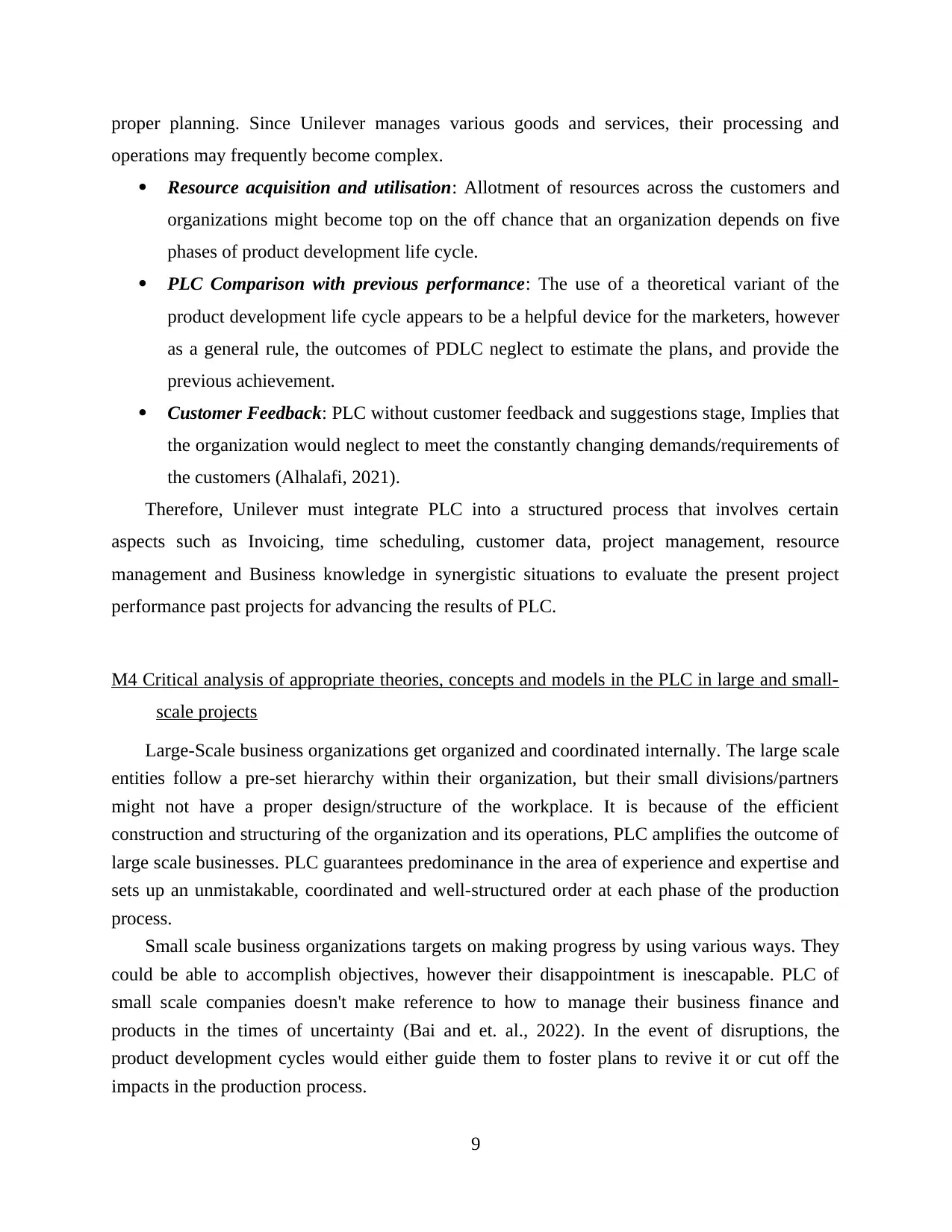
proper planning. Since Unilever manages various goods and services, their processing and
operations may frequently become complex.
Resource acquisition and utilisation: Allotment of resources across the customers and
organizations might become top on the off chance that an organization depends on five
phases of product development life cycle.
PLC Comparison with previous performance: The use of a theoretical variant of the
product development life cycle appears to be a helpful device for the marketers, however
as a general rule, the outcomes of PDLC neglect to estimate the plans, and provide the
previous achievement.
Customer Feedback: PLC without customer feedback and suggestions stage, Implies that
the organization would neglect to meet the constantly changing demands/requirements of
the customers (Alhalafi, 2021).
Therefore, Unilever must integrate PLC into a structured process that involves certain
aspects such as Invoicing, time scheduling, customer data, project management, resource
management and Business knowledge in synergistic situations to evaluate the present project
performance past projects for advancing the results of PLC.
M4 Critical analysis of appropriate theories, concepts and models in the PLC in large and small-
scale projects
Large-Scale business organizations get organized and coordinated internally. The large scale
entities follow a pre-set hierarchy within their organization, but their small divisions/partners
might not have a proper design/structure of the workplace. It is because of the efficient
construction and structuring of the organization and its operations, PLC amplifies the outcome of
large scale businesses. PLC guarantees predominance in the area of experience and expertise and
sets up an unmistakable, coordinated and well-structured order at each phase of the production
process.
Small scale business organizations targets on making progress by using various ways. They
could be able to accomplish objectives, however their disappointment is inescapable. PLC of
small scale companies doesn't make reference to how to manage their business finance and
products in the times of uncertainty (Bai and et. al., 2022). In the event of disruptions, the
product development cycles would either guide them to foster plans to revive it or cut off the
impacts in the production process.
9
operations may frequently become complex.
Resource acquisition and utilisation: Allotment of resources across the customers and
organizations might become top on the off chance that an organization depends on five
phases of product development life cycle.
PLC Comparison with previous performance: The use of a theoretical variant of the
product development life cycle appears to be a helpful device for the marketers, however
as a general rule, the outcomes of PDLC neglect to estimate the plans, and provide the
previous achievement.
Customer Feedback: PLC without customer feedback and suggestions stage, Implies that
the organization would neglect to meet the constantly changing demands/requirements of
the customers (Alhalafi, 2021).
Therefore, Unilever must integrate PLC into a structured process that involves certain
aspects such as Invoicing, time scheduling, customer data, project management, resource
management and Business knowledge in synergistic situations to evaluate the present project
performance past projects for advancing the results of PLC.
M4 Critical analysis of appropriate theories, concepts and models in the PLC in large and small-
scale projects
Large-Scale business organizations get organized and coordinated internally. The large scale
entities follow a pre-set hierarchy within their organization, but their small divisions/partners
might not have a proper design/structure of the workplace. It is because of the efficient
construction and structuring of the organization and its operations, PLC amplifies the outcome of
large scale businesses. PLC guarantees predominance in the area of experience and expertise and
sets up an unmistakable, coordinated and well-structured order at each phase of the production
process.
Small scale business organizations targets on making progress by using various ways. They
could be able to accomplish objectives, however their disappointment is inescapable. PLC of
small scale companies doesn't make reference to how to manage their business finance and
products in the times of uncertainty (Bai and et. al., 2022). In the event of disruptions, the
product development cycles would either guide them to foster plans to revive it or cut off the
impacts in the production process.
9
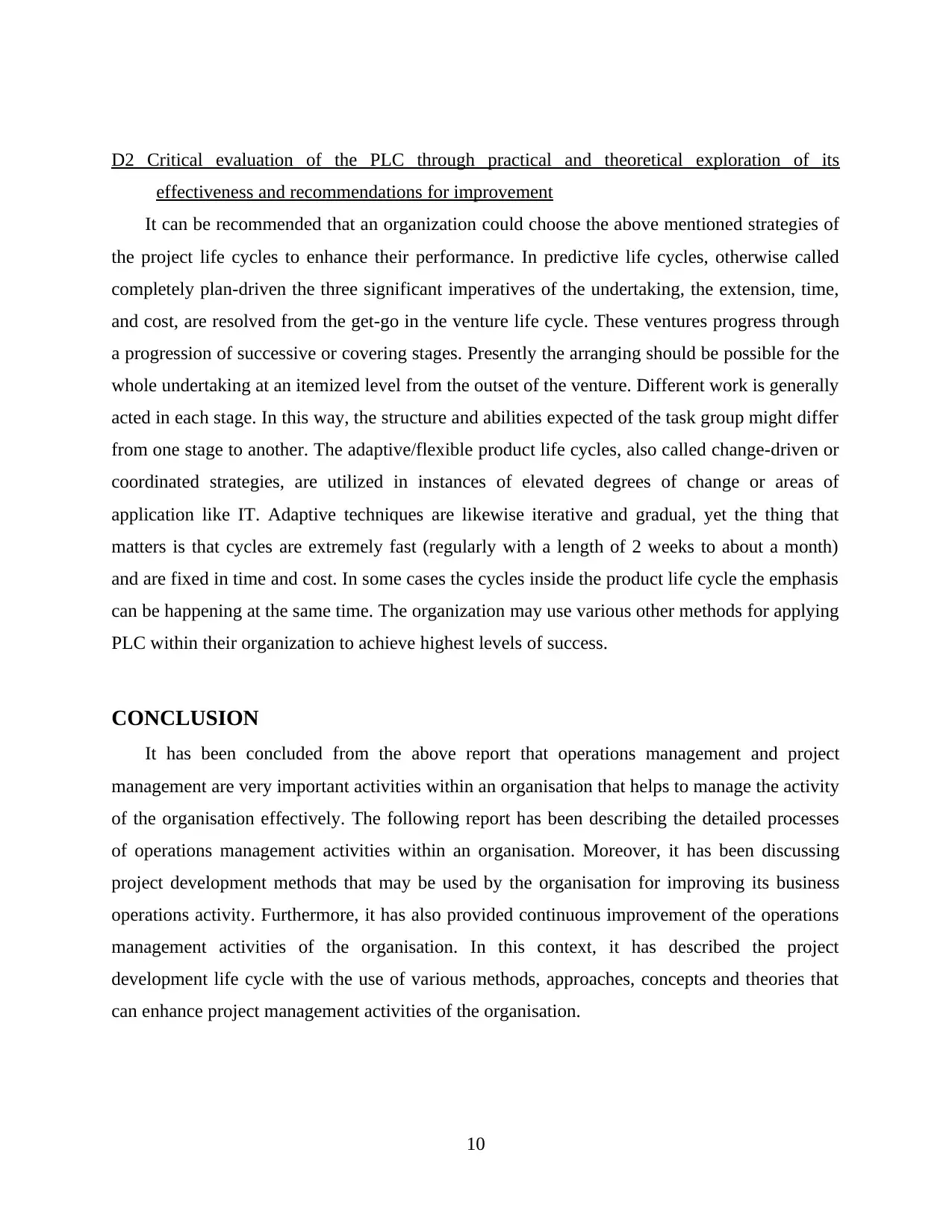
D2 Critical evaluation of the PLC through practical and theoretical exploration of its
effectiveness and recommendations for improvement
It can be recommended that an organization could choose the above mentioned strategies of
the project life cycles to enhance their performance. In predictive life cycles, otherwise called
completely plan-driven the three significant imperatives of the undertaking, the extension, time,
and cost, are resolved from the get-go in the venture life cycle. These ventures progress through
a progression of successive or covering stages. Presently the arranging should be possible for the
whole undertaking at an itemized level from the outset of the venture. Different work is generally
acted in each stage. In this way, the structure and abilities expected of the task group might differ
from one stage to another. The adaptive/flexible product life cycles, also called change-driven or
coordinated strategies, are utilized in instances of elevated degrees of change or areas of
application like IT. Adaptive techniques are likewise iterative and gradual, yet the thing that
matters is that cycles are extremely fast (regularly with a length of 2 weeks to about a month)
and are fixed in time and cost. In some cases the cycles inside the product life cycle the emphasis
can be happening at the same time. The organization may use various other methods for applying
PLC within their organization to achieve highest levels of success.
CONCLUSION
It has been concluded from the above report that operations management and project
management are very important activities within an organisation that helps to manage the activity
of the organisation effectively. The following report has been describing the detailed processes
of operations management activities within an organisation. Moreover, it has been discussing
project development methods that may be used by the organisation for improving its business
operations activity. Furthermore, it has also provided continuous improvement of the operations
management activities of the organisation. In this context, it has described the project
development life cycle with the use of various methods, approaches, concepts and theories that
can enhance project management activities of the organisation.
10
effectiveness and recommendations for improvement
It can be recommended that an organization could choose the above mentioned strategies of
the project life cycles to enhance their performance. In predictive life cycles, otherwise called
completely plan-driven the three significant imperatives of the undertaking, the extension, time,
and cost, are resolved from the get-go in the venture life cycle. These ventures progress through
a progression of successive or covering stages. Presently the arranging should be possible for the
whole undertaking at an itemized level from the outset of the venture. Different work is generally
acted in each stage. In this way, the structure and abilities expected of the task group might differ
from one stage to another. The adaptive/flexible product life cycles, also called change-driven or
coordinated strategies, are utilized in instances of elevated degrees of change or areas of
application like IT. Adaptive techniques are likewise iterative and gradual, yet the thing that
matters is that cycles are extremely fast (regularly with a length of 2 weeks to about a month)
and are fixed in time and cost. In some cases the cycles inside the product life cycle the emphasis
can be happening at the same time. The organization may use various other methods for applying
PLC within their organization to achieve highest levels of success.
CONCLUSION
It has been concluded from the above report that operations management and project
management are very important activities within an organisation that helps to manage the activity
of the organisation effectively. The following report has been describing the detailed processes
of operations management activities within an organisation. Moreover, it has been discussing
project development methods that may be used by the organisation for improving its business
operations activity. Furthermore, it has also provided continuous improvement of the operations
management activities of the organisation. In this context, it has described the project
development life cycle with the use of various methods, approaches, concepts and theories that
can enhance project management activities of the organisation.
10
⊘ This is a preview!⊘
Do you want full access?
Subscribe today to unlock all pages.

Trusted by 1+ million students worldwide
1 out of 14
Related Documents
Your All-in-One AI-Powered Toolkit for Academic Success.
+13062052269
info@desklib.com
Available 24*7 on WhatsApp / Email
![[object Object]](/_next/static/media/star-bottom.7253800d.svg)
Unlock your academic potential
Copyright © 2020–2025 A2Z Services. All Rights Reserved. Developed and managed by ZUCOL.




